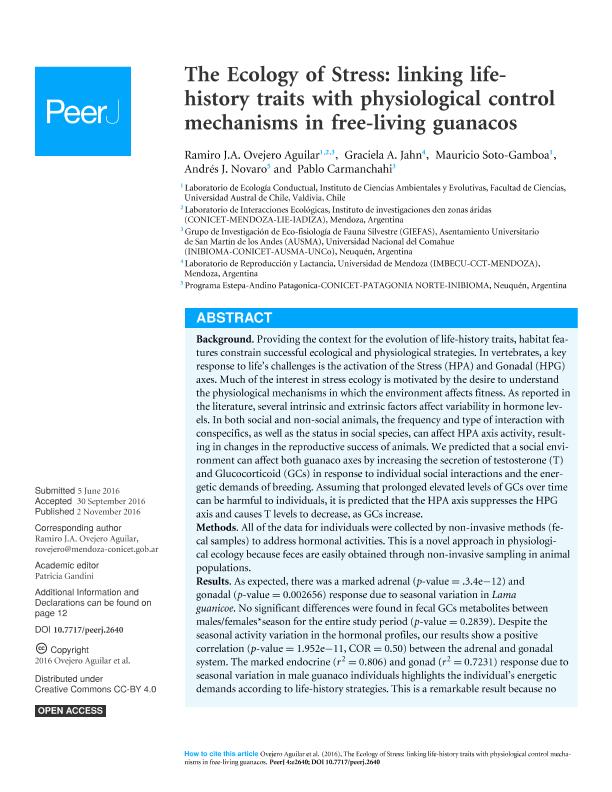Mostrar el registro sencillo del ítem
dc.contributor.author
Ovejero Aguilar, Ramiro Jose Antonio

dc.contributor.author
Jahn, Graciela Alma

dc.contributor.author
Soto Gamboa, Mauricio
dc.contributor.author
Novaro, Andres Jose

dc.contributor.author
Carmanchahi, Pablo Daniel

dc.date.available
2018-05-11T19:29:40Z
dc.date.issued
2016-10
dc.identifier.citation
Ovejero Aguilar, Ramiro Jose Antonio; Jahn, Graciela Alma; Soto Gamboa, Mauricio; Novaro, Andres Jose; Carmanchahi, Pablo Daniel; The Ecology of Stress: linking life- history traits with physiological control mechanisms in free-living guanacos; PeeJ Inc; PeerJ; 4; e2640; 10-2016; 1-21
dc.identifier.issn
2167-8359
dc.identifier.uri
http://hdl.handle.net/11336/44970
dc.description.abstract
Providing the context for the evolution of life-history traits, habitat features constrain successful ecological and physiological strategies. In vertebrates, a key response to life’s challenges is the activation of the Stress (HPA) and Gonadal (HPG) axes. Much of the interest in stress ecology is motivated by the desire to understand the physiological mechanisms in which the environment affects fitness. As reported in the literature, several intrinsic and extrinsic factors affect variability in hormone levels. In both social and non-social animals, the frequency and type of interaction with conspecifics, as well as the status in social species, can affect HPA axis activity, resulting in changes in the reproductive success of animals. We predicted that a social environment can affect both guanaco axes by increasing the secretion of testosterone (T) and Glucocorticoid (GCs) in response to individual social interactions and the energetic demands of breeding. Assuming that prolonged elevated levels of GCs over time can be harmful to individuals, it is predicted that the HPA axis suppresses the HPG axis and causes T levels to decrease, as GCs increase.
dc.format
application/pdf
dc.language.iso
eng
dc.publisher
PeeJ Inc
dc.rights
info:eu-repo/semantics/openAccess
dc.rights.uri
https://creativecommons.org/licenses/by/2.5/ar/
dc.subject
Stress Ecology
dc.subject
Reproduction
dc.subject
Lama Guanicoe
dc.subject
Sociality
dc.subject
Non-Invasive Methods
dc.subject
Hormonal Profiles in Wildlife
dc.subject.classification
Otras Ciencias Biológicas

dc.subject.classification
Ciencias Biológicas

dc.subject.classification
CIENCIAS NATURALES Y EXACTAS

dc.title
The Ecology of Stress: linking life- history traits with physiological control mechanisms in free-living guanacos
dc.type
info:eu-repo/semantics/article
dc.type
info:ar-repo/semantics/artículo
dc.type
info:eu-repo/semantics/publishedVersion
dc.date.updated
2018-04-18T14:55:30Z
dc.journal.volume
4
dc.journal.number
e2640
dc.journal.pagination
1-21
dc.journal.pais
Estados Unidos

dc.journal.ciudad
San Diego - California
dc.description.fil
Fil: Ovejero Aguilar, Ramiro Jose Antonio. Consejo Nacional de Investigaciones Científicas y Técnicas. Centro Científico Tecnológico Conicet - Mendoza. Instituto Argentino de Investigaciones de las Zonas Áridas. Provincia de Mendoza. Instituto Argentino de Investigaciones de las Zonas Áridas. Universidad Nacional de Cuyo. Instituto Argentino de Investigaciones de las Zonas Áridas; Argentina. Consejo Nacional de Investigaciones Científicas y Técnicas. Centro Científico Tecnológico Conicet - Patagonia Norte. Instituto de Investigaciones en Biodiversidad y Medioambiente. Universidad Nacional del Comahue. Centro Regional Universidad Bariloche. Instituto de Investigaciones en Biodiversidad y Medioambiente; Argentina. Universidad Austral de Chile. Facultad de Ciencias. Instituto de Ciencias Ambientales y Evolutivas; Chile
dc.description.fil
Fil: Jahn, Graciela Alma. Consejo Nacional de Investigaciones Científicas y Técnicas. Centro Científico Tecnológico Conicet - Mendoza. Instituto de Medicina y Biología Experimental de Cuyo; Argentina
dc.description.fil
Fil: Soto Gamboa, Mauricio. Universidad Austral de Chile. Facultad de Ciencias,
; Chile
dc.description.fil
Fil: Novaro, Andres Jose. Consejo Nacional de Investigaciones Científicas y Técnicas. Centro Científico Tecnológico Conicet - Patagonia Norte. Instituto de Investigaciones en Biodiversidad y Medioambiente. Universidad Nacional del Comahue. Centro Regional Universidad Bariloche. Instituto de Investigaciones en Biodiversidad y Medioambiente; Argentina
dc.description.fil
Fil: Carmanchahi, Pablo Daniel. Consejo Nacional de Investigaciones Científicas y Técnicas. Centro Científico Tecnológico Conicet - Patagonia Norte. Instituto de Investigaciones en Biodiversidad y Medioambiente. Universidad Nacional del Comahue. Centro Regional Universidad Bariloche. Instituto de Investigaciones en Biodiversidad y Medioambiente; Argentina
dc.journal.title
PeerJ
dc.relation.alternativeid
info:eu-repo/semantics/altIdentifier/doi/http://dx.doi.org/10.7717/peerj.2640
dc.relation.alternativeid
info:eu-repo/semantics/altIdentifier/url/https://peerj.com/articles/2640/
dc.relation.alternativeid
info:eu-repo/semantics/altIdentifier/url/https://www.ncbi.nlm.nih.gov/pmc/articles/PMC5101617/
Archivos asociados
